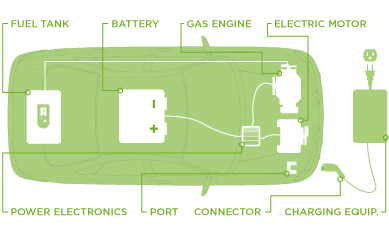About Charging
What Are Electric Vehicles
Powered by electric motors and batteries, electric vehicles are available in a variety of models with different ranges and capabilities. To recharge, they are plugged in to a source of electric power through Electric Vehicle Supply Equipment (EVSE).
In Vermont, the average distance a vehicle travels in a day is around 33 miles—making EVs capable of serving the mobility needs of most Vermonters. With the safety features built-in to all new vehicles and charging equipment, EVs can be operated and recharged in all types of indoor and outdoor conditions, such as rain, snow, cold, and other harsh environments.
Types of EVs
Plug in electric vehicles (EVs) come in a variety of shapes and sizes. There are two basic EV designs:

All-Electric Vehicles (AEVs)
Powered solely by electric energy stored in the battery
The Tesla Model 3, Nissan Leaf, Chevrolet Bolt and Hyundai Kona are examples of all-electric vehicles in Vermont.
Is it for me?
Good option for two-car households, those with shorter commutes, and EV lovers with a pioneering spirit. Range on the coldest Vermont days will be much less than the official manufacturer ratings. For example, an AEV with 200 miles of official range might be closer to 140 miles in frigid conditions, so this should be factored into vehicle purchase decisions.

Plug-In Hybrid Electric Vehicles (PHEVs)
Powered by a combination of battery power and gasoline engine
The Toyota Prius Prime, Honda Clarity PHEV, Mitsubishi Outlander PHEV and Kia Niro PHEV are examples of PHEVs. Generally they do not travel as far as all-electric vehicles on battery power, but when the battery runs low, the gasoline engine turns on to extend their range.
Is it for me?
Good option for single car households, regular road trippers, and others requiring more flexibility.
Types of Charging
 Level One Charging
Level One Charging
(120 Volts)
Level 1 charging uses the same 120-volt current found in standard household outlets and can be performed using the power cord and equipment that most EVs come with. Making this type of charging available on your business property is as simple as installing dedicated 120 volt outlets in your company parking lot.
Advantages
No installation cost if you already have an outlet near where your electric car is parked
Low impact on electric utility peak demand charges (often applied to commercial accounts)
Disadvantages
Slow charging, typically 3-5 miles of range per hour
 Level Two Charging
Level Two Charging
(240 Volts)
Level 2 charging uses 240 volt power to enable faster regeneration of an EV’s battery system. Providing this type of charging typically requires installation of an EVSE unit and electrical wiring capable of handling higher voltage power. Some automakers include portable charging equipment combining level 1 and level 2 charging capability that can plug directly into 240 volt receptacles. Plug-in America’s PlugStar tools offer a listing of Level 2 EVSE currently on the market. Many utilities are offering free level 2 charging equipment and/or incentives with an electric car purchase. Visit our incentives page to learn more.
Advantages
Faster charge time - typically 10 – 20 miles of range per hour of charge
More energy efficient than Level 1 - about 3% gain in efficiency
Variety of EV charging manufacturers provides differentiated products for distinct markets and requirements, including networked systems that can schedule charging, track use, and collect fees
Disadvantages
More expensive than Level 1
Potentially higher impact on peak kilowatt demand charges for businesses
DC fast charging provides compatible vehicles with an 80% charge in 30-60 minutes by converting high voltage AC power to DC power for direct storage in EV batteries. Automakers currently use the same Society of Automotive Engineers (SAE) J-1772 plug for level 1 and 2 charging, with the exception of Tesla which has an adapter. For DC fast charging there are three plug types used by different automakers: the CHAdeMO, SAE Combined Charging System (Combo/CCS), and Tesla Supercharger. Nissan and Mitsubishi vehicles use CHAdeMO while current and upcoming vehicles from US and European manufacturers have SAE CCS ports.
Tesla's Supercharger plug is only compatible with Tesla vehicles, although they offer an adapter which allows Tesla owners to use SAE CCS equipment and are starting to make some Supercharger locations available to non-Tesla drivers through their Supercharger to CCS "magic dock" adapter.
Our electric car fact sheet includes a table with information on DC fast charging plug types by model. Most DC fast charging equipment manufacturers now offer equipment with both the CHAdeMO and SAE CCS port connectors to increase compatibility.
Advantages
Charge time is reduced drastically--it's nearly as fast as refueling a gasoline vehicle
Variety of charging equipment manufacturers provides differentiated products for distinct markets and requirements
Disadvantages
Significantly more expensive than Level 1 or Level 2 equipment and high voltage 3 phase power connections to utilities further increases installation costs
Potentially increased peak demand charges for commercial locations
Different plug types are confusing to potential EV buyers and charging station operators
Depending on the vehicle and charging equipment, fast charging can be slowed during cold weather
Charging Installation Guide
Most EV owners do their charging at home overnight. However, public and workplace charging offers many benefits for businesses, employees, and customers. Our EV charging installation guide provides detailed information on commercial installation applications, as well as some notes on residential installations, including at multifamily housing.